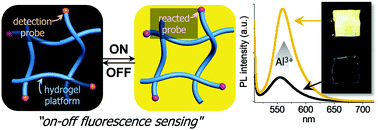Facile fluorescent labeling of a polyacrylamide-based hydrogel film via radical initiation enables selective and reversible detection of Al3+†
Abstract
Stimuli-responsive hydrogels have attracted significant attention for their promising characteristics and have been used in diverse platforms developed for practical applications. When processed as films, these hydrogels show enhanced properties, including faster responses and higher loading capacities, and enhanced interfacial interactions. In this study, we prepared a functional polyacrylamide hydrogel film containing a rhodamine-based probe. The probe plays two fundamental roles: in the fabrication of the film via redox-initiated radical polymerization and in providing a fluorescence response to Al3+. The amine-containing probe initiated the polymerization reaction at room temperature; the resulting film synthesized through the one-step reaction was transparent and stretchable, elongating by more than five times under tensile tension. The fluorogenic probe in the film showed a sensitive, selective response to Al3+ with a detection limit of 1.5 μM. Furthermore, after detection, the addition of ethylenediaminetetraacetic acid (EDTA) to the film turned off the fluorescence from the probe; this facilitated reversible fluorescence sensing when the film was repeatedly exposed to Al3+, as expected. The facile preparation method can be expanded to incorporate other multi-functional amine probes that can impart hydrogel films with autonomous, responsive systems.



 Please wait while we load your content...
Please wait while we load your content...